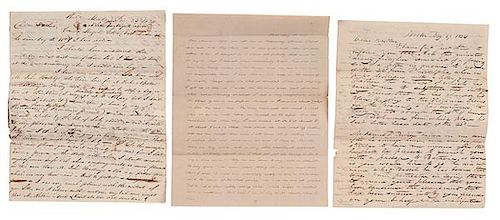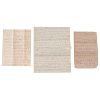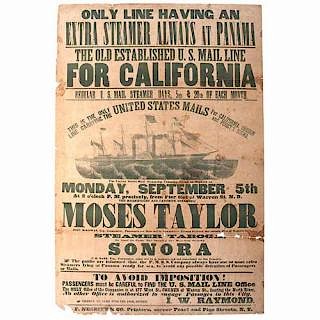Paul Revere, War of 1812, Mechanics of the Town of Boston Signed Pledge
About Seller
6270 Este Ave.
Cincinnati , OH 45232
United States
With offices in Cincinnati, Cleveland and Denver, Cowan’s holds over 40 auctions each year, with annual sales exceeding $16M. We reach buyers around the globe, and take pride in our reputation for integrity, customer service and great results. A full-service house, Cowan’s Auctions specializes in Am...Read more
Two ways to bid:
- Leave a max absentee bid and the platform will bid on your behalf up to your maximum bid during the live auction.
- Bid live during the auction and your bids will be submitted real-time to the auctioneer.
Bid Increments
| Price | Bid Increment |
|---|---|
| $0 | $25 |
| $500 | $50 |
| $1,000 | $100 |
| $2,000 | $250 |
| $5,000 | $500 |
| $10,000 | $1,000 |
| $20,000 | $2,500 |
| $50,000 | $5,000 |
| $100,000 | $10,000 |
About Auction
Jun 10, 2016 - Jun 11, 2016
Cowan's Auctions dawnie@cowans.com
- Lot Description
Paul Revere, War of 1812, Mechanics of the Town of Boston Signed Pledge
Lot of 6, featuring a pledge drafted by Paul Revere in a 3.75 x 6.25 in. paper bound bank notebook, promising to aid Boston during the War of 1812. Signed by Revere and 120 other members of the Mechanics of the Town of Boston, dated September 8, 1814. Also includes 5 Harris family letters, ca 1834-1858.
Age did not inhibit 79-year-old patriot, Paul Revere from aiding Americans against the British, again.
The subscribers, Mechanics of the Town of Boston do evince our readiness to cooperate by manual labor in measures for the defense of the Town and naval arsenal, do hereby tender our services to his Excellency the Commander in Chief to be directed in such manner as he shall consider at this eventful crisis, most conducive to the public good, wrote Revere (Boston, September 8, 1814).
Revere entrusted the small notebook, with his promise of three days’ labor, to Isaac Harris, a mast and spar maker who owned well-known ship yard next to Winnisimmet Ferry. Harris carried the notebook to 120 other merchants and laborers in the North End of Boston, entreating them to sacrifice their bodies or their businesses to protect their city against the British fleet cruising outside Boston Harbor.
The diverse signatories include: Benjamin Coomey, a mast and spar maker; James Kirkwood, a soap maker; Isaac Harris; William D. Hills; Samuel Aspinwall, Harris’ apprentice; Charles Welles, a mason; George Darracoat, a ship chandler; Nathaniel Clark, a printer;H. Hutchinson; Thomas Lillie; Jacob Hall; N.J. Snelling; Salmer Clap; Edw B.Walker; Josiah Snelling; Samuel Price; George Robinson, a grocer; Thomas Green; Samuel Winslow, a sexton; William Green; Thomas Edes; Henry Turner; Johnathan Cary, brother-in-law of Harris, who was also a spar and mast maker; Samuel Brown, Cary’s partner; Parker Emerson Jr.; Seth Lothrop; Nathaniel Lane; Caleb Wilson, an Irish drain digger; Elisha Nortcorss; William Barnicoat; Louis Lincoln, Harris’ neighbor; Stephen Glubb; William Porter; Rufus Baxter; A.E. Lincoln; Daniel T. Lewis, a cooper; Asa Holbrook; Nathaniel Nottage, a house carpenter; Nathaniel Nottage, Jr.; John Eliot; Amos Lincoln; James Robinson; J. Bray, a major of the militia; William Tompkins; Zeph Sampson; John Childs; Thomas Lewis; Eben Tufts; James Rouse; John F. Truman; Martin Bates; Samuel Parker; Othniel Trench; William Bell, Jr.; Samuel Townsend; Henry J. Oliver; Joseph Woodcock, carpenter and constable; N. Bridge; James Armstrong; Samuel Pierce; John M. Jennison; Isaac Poor; Thomas Avis; Jas Weld; D.D. Pulsifer; Nathaniel Clarke; Bradley Cummings; Ebenezer Andrews; Joseph Urann; John Thayer; Joel Trull; Andrew Drumond; John Fenno; Thomas Pool; Thomas Brooks Pratt; Thomas Badger; Thomas Mickell; Benjamin White; Edward Oliver; Charles Pook, father of Naval Constructor Samuel Pook; Edward Chessman; William Collier; William Burrows; G. Hammond; Thomas S. Bordman; Abijah Luce; Elkanah Cushman; Samuel Topliff W.J. Hammatt; Larkin Snow; Amos Binney, Naval contractor and captain of the militia; Elisha Webb, schoolmaster; E. Little, teacher; John Ripley; Thomas Whitman; William Wiswell; John Low; Ephm Tufts; Ebenr Rhoades; Adam French; John Sholes; Thos Codman; Wiliam Green; William Bell; Ephriam Snow; John Smith; William C. Parke; Robert Lash Jr., bank teller; Charles Belamy; Otis Fay; William P. Shelton; A.L. Stevens; Caleb B. Munroe; W. Mills; Jas Holbrook; George Prince; J.B. Barnes; and Peter Seaver.
The men kept their promise. Governor of Massachusetts, Caleb Strong, enlisted the Mechanics to construct a Fort on either Williams or Noodle’s Island. Twelve-year-old Nathaniel H. Cary, Harris’ nephew and Johnathan Cary’s son, helped his father and uncles build it. In addition to their sweat, the men offered their blood to protect it. The British assault never came, but all 120 remained ready to “defend it to the last man.” (Massachusetts Historical Society, Proceedings of the Massachusetts Historical Society, 1901, p 151)
Henry N. Hooper Jr. received the book from his grandfather, Isaac Harris, after his death in 1868 and wrote an inscription on the front cover. In 1901, Nathaniel H. Cary’s son, Isaac Harris Cary, presented it to Rev. Henry F. Jenks, a board member of the Massachusetts Historical Society. During a board meeting Jenks read a letter with his findings, “It is probable that the well-worded caption was drawn up by Paul Revere, who was the first signer, the writing and signature being similar,” read Jenks. “The book is about the size of an ordinary bank deposit book, with paper covers, and it is in a good state of preservation. The names are entered each in his own handwriting. When the times is not specified, it is inferred that the signer would work as his services were needed” (Massachusetts Historical Society, Proceedings of the Massachusetts Historical Society, 1901, p. 149).
The book has remained in the family since that time.
Many of the five letters are addressed to Isaac Harris from his wife, Eunice or his son, William. One letter is written by Isaac to his granddaughter, Carrie Hooper. The letters discuss family visits and other happenings around Boston.
To learn more about the history surrounding the notebook, please read: Massachusetts Historical Society, Proceedings of the Massachusetts Historical Society, 1901, p. 149-154
Provenance: Descended Directly in the Family of Henry Northey Hooper, Jr.Very good condition, some toning of the papers.Condition
- Shipping Info
-
SHIPPING. At the request of the buyer, Cowan's will authorize the shipment of purchased items. Shipments usually occur within two weeks after payment has been received. Shipment is generally made via UPS Ground service. Unless buyer gives special instructions, the shipping method shall be at the sole discretion of Cowan's Auctions, Inc.. Cowan's is in no way responsible for the acts or omissions of independent handlers, packers or shippers of purchased items or for any loss, damage or delay from the packing or shipping of any property.
-
- Buyer's Premium



 EUR
EUR CAD
CAD AUD
AUD GBP
GBP MXN
MXN HKD
HKD CNY
CNY MYR
MYR SEK
SEK SGD
SGD CHF
CHF THB
THB












